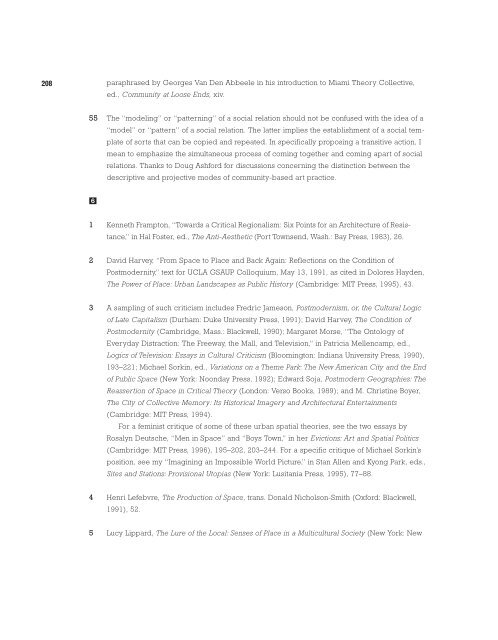ONE PLACE AFTER ANOTHER - Monoskop
ONE PLACE AFTER ANOTHER - Monoskop
ONE PLACE AFTER ANOTHER - Monoskop
Create successful ePaper yourself
Turn your PDF publications into a flip-book with our unique Google optimized e-Paper software.
208<br />
paraphrased by Georges Van Den Abbeele in his introduction to Miami Theory Collective,<br />
ed., Community at Loose Ends, xiv.<br />
55 The “modeling” or “patterning” of a social relation should not be confused with the idea of a<br />
�<br />
“model” or “pattern” of a social relation. The latter implies the establishment of a social tem-<br />
plate of sorts that can be copied and repeated. In specifically proposing a transitive action, I<br />
mean to emphasize the simultaneous process of coming together and coming apart of social<br />
relations. Thanks to Doug Ashford for discussions concerning the distinction between the<br />
descriptive and projective modes of community-based art practice.<br />
1 Kenneth Frampton, “Towards a Critical Regionalism: Six Points for an Architecture of Resis-<br />
tance,” in Hal Foster, ed., The Anti-Aesthetic (Port Townsend, Wash.: Bay Press, 1983), 26.<br />
2 David Harvey, “From Space to Place and Back Again: Reflections on the Condition of<br />
Postmodernity,” text for UCLA GSAUP Colloquium, May 13, 1991, as cited in Dolores Hayden,<br />
The Power of Place: Urban Landscapes as Public History (Cambridge: MIT Press, 1995), 43.<br />
3 A sampling of such criticism includes Fredric Jameson, Postmodernism, or, the Cultural Logic<br />
of Late Capitalism (Durham: Duke University Press, 1991); David Harvey, The Condition of<br />
Postmodernity (Cambridge, Mass.: Blackwell, 1990); Margaret Morse, “The Ontology of<br />
Everyday Distraction: The Freeway, the Mall, and Television,” in Patricia Mellencamp, ed.,<br />
Logics of Television: Essays in Cultural Criticism (Bloomington: Indiana University Press, 1990),<br />
193–221; Michael Sorkin, ed., Variations on a Theme Park: The New American City and the End<br />
of Public Space (New York: Noonday Press, 1992); Edward Soja, Postmodern Geographies: The<br />
Reassertion of Space in Critical Theory (London: Verso Books, 1989); and M. Christine Boyer,<br />
The City of Collective Memory: Its Historical Imagery and Architectural Entertainments<br />
(Cambridge: MIT Press, 1994).<br />
For a feminist critique of some of these urban spatial theories, see the two essays by<br />
Rosalyn Deutsche, “Men in Space” and “Boys Town,” in her Evictions: Art and Spatial Politics<br />
(Cambridge: MIT Press, 1996), 195–202, 203–244. For a specific critique of Michael Sorkin’s<br />
position, see my “Imagining an Impossible World Picture,” in Stan Allen and Kyong Park, eds.,<br />
Sites and Stations: Provisional Utopias (New York: Lusitania Press, 1995), 77–88.<br />
4 Henri Lefebvre, The Production of Space, trans. Donald Nicholson-Smith (Oxford: Blackwell,<br />
1991), 52.<br />
5 Lucy Lippard, The Lure of the Local: Senses of Place in a Multicultural Society (New York: New

















